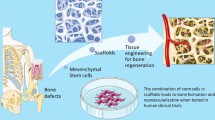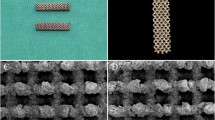Abstract
Introduction
In the last few years, great interest has been focused on tissue engineering as a potential therapeutic approach for musculoskeletal diseases. The role of metallic implants for spinal fusion has been tested in preclinical and clinical settings. Titanium and tantalum have excellent biocompatibility and mechanical properties and are being used in this situation. On the other hand, the therapeutic role of mesenchymal stem cells (MSC) is extensively explored for their multilineage differentiation into osteoblasts.
Objetives
In vitro comparision of titanium and tantalum as MSCs scaffolds.
Material and methods
In the present study, we have compared the in vitro expansion capacity, viability, immunophenotype (both explored by flow cytometry) and multi-differentiation ability of MSC cultured in the presence of either titanium or tantalum fragments. The adherence of MSC to either metal was demonstrated by electron microscopy.
Results
Both metals were able to carry MSC when transferred to new culture flasks. In addition, our study shows that culture of MSC with titanium or tantalum improves cell viability and maintains all their biological properties, with no significant differences regarding the metal employed.
Conclusion
This would support the use of these combinations for clinical purposes, especially in the spinal fusion and reconstruction setting.








Similar content being viewed by others
References
Atala A (2004) Tissue engineering and regenerative medicine: concepts for clinical application. Rejuvenation Res 7:15–31
Anselme K (2000) Osteoblast adhesion on biomaterial. Biomaterials 21:667–681
Barry FP, Murphy JM (2004) Mesenchymal stem cells: clinical applications and biological characterization. Int J Biochem Cell Biol 36:568–584
Bobyn JD, Stckpool G, Hacking SA, Tanzer M, Krygier JJ (1999) Characteristics of bone ingrowth and interface mechanics of a new porous tantalum biomaterial. J Bone Joint Surg Br 81:907–914
Bruder SP, Kraus KH, Goldberg VM, Kadiyala S (1998) The effect of implants loaded with autologous mesenchymal stem cells on the healing of canine segmental bone defects. J Bone J Surg Am 80:985–996
Carrancio S, López-Holgado N, Sanchez-Guijo MF et al (2008) Optimization of mesenchymal stem cell expansion procedures by cell separation and culture conditions modification. Exp Hematol 36:1014–1021
Cassinelli EH, Wallach C, Hanscom B, Vogt M, Kang JD (2006) Prospective clinical outcomes of revision fusion surgery in patients with pseudoarthrosis after posterior lumbar interbody fusions using stand-alone metallic cages. Spine J 6:428–434
D’Angelo F, Murena L, Campagnolo M, Zatti G, Cherubino P (2008) Analysis of bone ingrowth on a tantalum cup. Indian J Orthop 42:275–278
Dominici M, Le BK, Mueller I et al (2006) Minimal criteria for defining multipotent mesenchymal stem cells. The international society for cellular therapy position statement. Cytotherapy 8:315–317
Fu TS, Chen WJ, Chen LH, Lin SS, Liu SJ, Ueng SW (2009) Enhancement of posterolateral lumbar spine fusion using low-dose rhBMP-2 and cultured marrow stromal cells. J Orthop Res 27:380–384
Gan Y, Dai K, Zhang P, Tang T, Zhu Z, Lu J (2008) The clinical use of enriched bone marrow stem cells combined with porous beta-tricalcium phosphate in posterior spinal fusion. Biomaterials 29:3973–3982
Gastaldi G, Asti A, Scaffino MF, Visai L, Saino E, Cometa AM, Benazzo F (2010) Human adipose-derived stem cells (hASCs) proliferate and differentiate in osteoblast-like cells on trabecular titanium scaffolds. J Biomed Mater Res A 94:790–799
Gottfried ON, Dailey AT (2008) Mesenchymal stem cell and gene therapies for spinal fusion. Neurosurgery 63(3):380–391
Kraus KH, Kirker-Head C (2006) Mesenchymal stem cells and bone regeneration. Vet Surg 35(3):232–242
Koga A, Tokuhashi Y, Ohkawa A, Nishimura T, Takayama K, Ryu J (2008) Effects of fibronectin on osteoinductive capability of fresh iliac bone marrow aspirate in posterolateral spinal fusion in rabbits. Spine 33:1318–1323
Le Blanc K, Pittenger M (2005) Mesenchymal stem cells: progress toward promise. Cytotherapy 7:36–45
Marcacci M, Kon E, Moukhachev V, Laurokov A, Kutepof S, Quarto R, Mastrogiacomo M, Cancedda R (2007) Stem cells associated with macroporous bioceramics for long bone repair: 6- to 7-year outcome of a pilot clinical study. Tissue Eng 13:947–955
Nakajima T, Iizuka H, Tsutsumi S, Kayakabe M, Takagishi K (2007) Evaluation of posterolateral spinal fusion using mesenchymal stem cells: differences with or without osteogenic differentiation. Spine 32:2432–2436
Sanchez-Guijo F, Blanco JF, Cruz G et al (2009) Multiparametric comparison of mesenchymal stromal cells obtained from trabecular bone by using a novel isolation method with those obtained by iliac crest aspiration from the same subjects. Cell Tissue Res 336:501–507
Sjostrom T, Dalby MJ, Hart A, Tare R, Oreffo ROC, Su B (2009) Fabrication of pillar-like titania nanostructures on titanium and their interaction with human skeletal stem cells. Acta Biomater 5:1433–1441
Stiehler M, Seib FP, Rauh J, Goedecke A, Werner C, Bornhäuser M, Günther KP, Bernstein P (2010) Cancellous bone allograft seeded with human mesenchymal stromal cells: a potential good manufacturing practice-grade tool for the regeneration of bone defects. Cytotherapy 12:658–668
Stiehler M, Lind M, Mygind T et al (2008) Morphology, proliferation, and osteogenic differentiation of mesenchymal stem cells cultured on titanium, tantalum, and chromium surfaces. J Biomed Mater Res A 86:448–458
Wazen RM, Lefebvre LP, Baril E, Nanci A (2010) Initial evaluation of bone ingrowth into a novel porous titanium coating. J Mater Res B Appl Biomater 94:64–71
Weinad C, Pomerantseva I, Neville CM, Gupta R et al (2006) Hydrogel-beta-TCP scaffolds and stem cells for tissue engineering bone. Bone 38:555–563
Xiuxin H, Yue Z, Cui C, Yajun W (2009) A meta-Analysis of circuferential fusion versus instrumented posterolateral fusion in the lumbar spine. Spine 34:E618–E625
Zhou C, Zhan E, Lin M, Zeng S (2008) Preparation, microstructure and mechanical properties of porous titanium sintered by Ti fibres. J Mater Sci Mater Med 19:401–405
Conflict of interest
None.
Author information
Authors and Affiliations
Corresponding author
Rights and permissions
About this article
Cite this article
Blanco, J.F., Sánchez-Guijo, F.M., Carrancio, S. et al. Titanium and tantalum as mesenchymal stem cell scaffolds for spinal fusion: an in vitro comparative study. Eur Spine J 20 (Suppl 3), 353 (2011). https://doi.org/10.1007/s00586-011-1901-8
Received:
Revised:
Accepted:
Published:
DOI: https://doi.org/10.1007/s00586-011-1901-8




